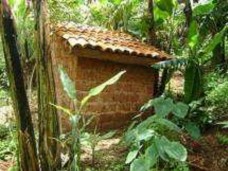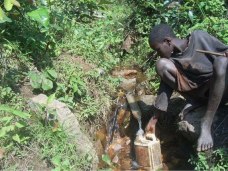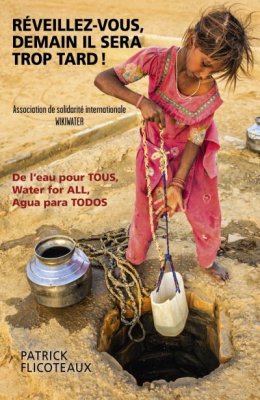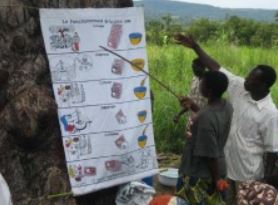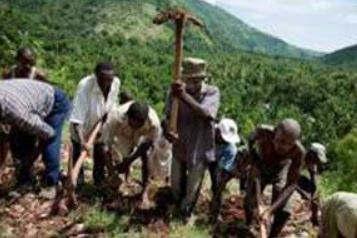1) What is involved ?
As indicated in the two previous fact sheets C5 and C6, there are various organisations with the purpose of managing water facilities in developing countries.
Here, we will present three examples of such organisations set up in the Caritas Internationalis network (162 countries) for which the implementation has shown to be a success.
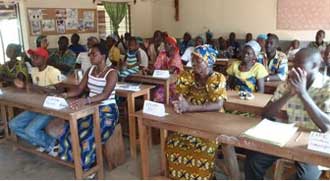
General meeting of a Caritas TOGO water and sanitation management committee in the region of Savanes. 
2) First example
Access to water structuring of local communities for a sustainable management of the hydraulic and sanitary infrastructures in BURUNDI (diocese of GITEGA).
a) Purpose of this three-year programme (2009-2011) carried out by ODAG (CARITAS diocese of GITEGA through co-financing with SEDIF (Intercommunity syndicate for Water of Ile de France) and AESN (Seine Normandy Water Agency)
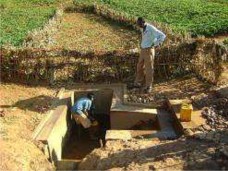
Collection and improvement of a source. 
Photo : Caritas Burundi
Substantially improve the coverage of the needs in drinking water and in sanitation of the population of two large towns of Buraza and Bukirasazi and to set it up in a sustainable, fair and controlled manner, by the local stakeholders by creating participative community management structures.
- Collection and improvement of 143 sources,
- Creation of 4 gravity-fed water adduction systems several km long
- Construction of 5 school 5 latrines,
- Setting up 5 rainwater collection systems in schools
- Manufacture of 300 family latrines
- Training on hygiene and health
Set up of 143 management committees for the sources, 4 for the adductions and 5 "joint hygiene clubs" in schools.
- Total cost : €355,000. Beneficiaries : 47,000
b) Achievements
Collaboration with the State and its decentralised departments
ODAG works very closely with the General Directorate on rural hydraulics and energy (DGHER) with which it has signed a protocol for collaboration and to which in particular it submits its action plans for approval each year. It also sends its achievement reports and provides it with the nature and the setup locations of its diverse achievements.
It also involves other structures such as provincial and town administrations, RCE (Community Water Boards), Health Centres and schools.
Identification and formation of leaders of communities and RCEs
ODAG first identified, thanks to its leaders in the field, 4 benevolent leaders (who received travel indemnities only) in each of the two towns in order to make use of them as "relay persons" in order to make aware, involve and train the benefitting populations, then trained them in making communities aware and in the main aspects of the programme for 2 days.
Setting up Management Committees
ODAG first formed temporary management committees for the hydraulic structures by selecting 3 to 5 people, including 3 men and 2 women, from among the people who most actively participated in the first awareness sessions for all of the population. Their role consisted in pursuing the involvement of the population for the community participation, in monitoring and in managing the materials intended for the construction of structures.
Right from the first half-year of the starting of the programme, 73 temporary management committees (one committee per standpost) had been set up.
When the structures were finished, it was suggested to the population to transform these committees, or to change the composition of them, into final committees then in charge of the proper use of the structures, maintaining them, repairing them and collecting contributions.
In parallel, in light of its substantial programme of constructing latrines and of informing about hygiene and health, ODAG created "joint hygiene clubs" in the primary schools comprised of about ten people (students, teachers, and parents of students).
|
|
Support for the reinforcing of two Community Water Boards (RCE)
Once formed, all of the Management committees formed gathered together in a general meeting at each of the two towns in order to form a new RCE, as the previous ones were not operating well, and file its statutes with the Ministry of the Interior.
Each Community Water Board :
- organises preparatory workshop in each town with the leaders, the elected officials and the local administration in order to define the role and the involvement of each person,
- elects an Executive Board and work commissions,
- assumes, through delegation from the town and in concertation with the town’s elected officials, the management and the monitoring of the structures,
- defines with the local authorities the role and the attributions of the RCE as well as the royalties.
- trains its managers in financial and organisational management, and in developing action plans
and in preparing budgets that it defines annually,
- acquires operating buildings and logistics means provided with office equipment,
- organises the collection of the royalties and their security on appropriate accounts,
- ensures the maintenance and renewal of the facilities and signs where applicable maintenance contracts with local artisans or creates a technical department.
In order to assist the RCE in fulfilling their role, ODAG has :
- made elected officials aware of their role and their responsibilities,
- trained the RCE in administrative and financial management as well as in collecting royalties,
- supported the RCE in developing their budget and their action plan,
Means implemented
The entire programme was able to be carried out thanks to the very strong involvement of the population, the creation of management committees, Community water boards and joint hygiene clubs, to an ODAG project team comprised of 13 people including a project manager and his deputy, 3 supervisors, 3 leaders, 1 driver and 4 maintenance personnel, the use of a 4x4, 3 motorcycles and a computer and the creation of pedagogical tools (5 facilitation kits).
It is planned to continue this programme from 2012 to 2014 in two new larger towns in the provinces of Mwaro and Gitega benefitting 65,000 people.
3) Second example
CARITAS ETHIOPIA : Accompanying community dynamics for improving access to water and sanitation and in hygiene awareness
a) Objective of the programme (co-financed by the Ministry of foreign affairs)
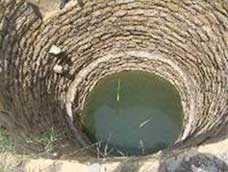 Assist the particularly poor rural population of 15 districts (tabias) of the region of Tigray in northern Ethiopia in acquiring and in managing itself a three-year programme starting in 2011 (Sep. 2008-August 2011) for improving the conditions of life and health of 26,000 beneficiaries :
Assist the particularly poor rural population of 15 districts (tabias) of the region of Tigray in northern Ethiopia in acquiring and in managing itself a three-year programme starting in 2011 (Sep. 2008-August 2011) for improving the conditions of life and health of 26,000 beneficiaries :
- creation of 72 "Water-Sanitation" management committees with the recording of statutes and training in these Committees of 153 referral agents in the PHAST method for hygiene awareness
- creation of 40 drillings and 24 wells equipped with pumps- collecting and improving two sources,
- construction of 2 tanks for recovering rainwater,
- setting up a database of the water points,
- building 600 latrines,
- laying out 2 perimeters for vegetable gardens in order to increase the revenue of 32 families (4 wells and two sources).
- Total cost : €572,000
b Achievements
Creation and official recognition of a "water and sanitation" management committee in each water point.
The leaders, technicians and sociologists of Caritas Ethiopia first organised information and training meetings in order to make the population aware of the importance and of the content of the tasks that it will would have to carry out itself.
They then organised community meetings in order to explain the interest in setting up management committees and the way to elect them democratically. During these meetings, the villagers discussed the manner in which the Committees would be comprised (here, 3 mean and 3 women) and how the elections would be held, the criteria for choosing candidates, the role of the members of the Committees… Once each community had reached an agreement on these various points, elections were organised everywhere to elect the members of the committees and of the various commissions created (4).
Setting up Management Committees
Once elected, all of the members benefitted from general training or training more specific to the nature of their functions.
A convention was signed between Caritas Ethiopia and each Committee in order to officialise the conditions defined beforehand for the participation of the population in the carrying out and in the monitoring of the programme (examples : contribution in terms of benevolent manpower, supply of local materials, financial participation…)
Development of a statute and rules of procedure
In order to define the rules for operating, using and maintaining the water points then officialised in a set of rules of procedure for the water point, meetings were organised within each committee but also with the population in order to allow it to contribute to the issues that should be mentioned in the statutes.
Numerous issues were raised during the debates. Examples : closing and opening times, amount and type of contributions (lump-sum ? by volume ? by month ?...), compensation for the agent (yes ?, no ?, in kind ?, in cash ? amount ? ), consequences for people who do not pay the contributions…
Once adopted, these statutes were registered with the woredas authorities. A current trend consists in gathering together all of the users of water points within official associations of which the purpose and operation are subject to statues drafted by the communities and Caritas Ethiopia in relation with the authorities and registered with the woreda authorities.
Training for members of the "water and sanitation" committees
Organised in 2 phases, a practical and a theoretical phase, the latter especially covered the duties and the responsibilities of each member of the committees, on the management methods of the water points (royalties, budgets, opening of a bank account, financial control, etc.), the method for operating and maintaining the water pumps, the compiling of a database on the main characteristics and possible breakdowns of the facilities, database which are sent on a periodical basis to the water departments of the region and of woreda, and finally and above all, within the framework of a specific programme, the issues concerning hygiene and health.
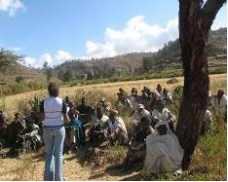
A training session in the field for the villagers of Saesi-Tseada
Choosing and setting up a water pricing system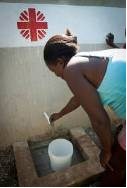 Meetings were organised beforehand with all of the population in order to explain the various elements in the coast of water and the need to constitute financial provisions for maintaining check structure.
Meetings were organised beforehand with all of the population in order to explain the various elements in the coast of water and the need to constitute financial provisions for maintaining check structure.
Then, each committee was given the liberty to define its own rules (whether or not to have a monthly contribution, lump-sum or by volume, by litre or by bucket, etc.). Most chose contributions via volume and most often by kettle or jerrican (5 to 15 Birr cents, or 0.4 to 1.2 euro centimes), several preferred a lump-sum monthly contribution of 1 to 3 birr per household, i.e. 8 to 25 euro centimes.
4) Third example
Access in TOGO to water and sanitation, rendering accountable, rendering autonomous and organisation of the populations for sustained management of the facilities and hygiene and health awareness.
Three-year programme (2009-2011) created by JARC (Movement of Catholic Agricultural and Rural Youth) in partnership with CARITAS of TOGO and co-financed by the "Grand Lyon-Veolia" and "SOGREAH" (Grenoble) Foundations.
a) Objective of this programme
- construction of 30 new large-diameter wells, deepening of 2 dried-up wells.
- creating 6 new surface layouts for existing wells ;
- 15 drillings
- development of 15 family latrines
- creation of a management committee in each water point,
- training/awareness of the beneficiaries of the structures for sustainable management of the resources.
- Cost : €490,000. Beneficiaries : 14,000 people
b) Achievements
Choosing the benefitting groups
As this conditions the success and the perpetual nature of the programme and precedes the setting up of participative management for the facilities, this constituted the first step in the programme.
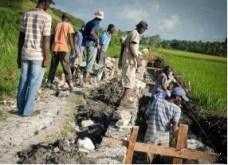 The conditions that the villages had to satisfy in order to obtain a new water point were as follows :
The conditions that the villages had to satisfy in order to obtain a new water point were as follows :
- designation of a Water Committee ;
- constitution of a Water Fund at a constant level of one hundred and sixty thousand FCFA (minimum 100,000 CFA for a well and 160,000 francs CFA for a drilling) ;
- opening of a savings account where the amount of the Water Fund is deposited ;
- construction of the structure for protecting the water point (enclosure) ;
- constitution of a stock of spare parts at the village level (for the case with drillings) ;
- village commitment to maintain the water point in good working order and clean
- village commitment to supply non-qualified physical labour (sinking work, picking up aggregates, etc.)
- village commitment to host and feed the technical team provided by the JARC in order to carry out the work
A survey / study of the environment was in parallel systematically carried out in order to establish a precise diagnostic of the needs.
The commitments made by the villages were materialised via the signing of a contract between JARC and the community before the work was launched.
Forming the water point management committees
The method of implementation (vote, designation, etc.) was left to the discretion of the village. The JARC leader played the role only of a facilitator in setting up the committee, complying with the desires of the populations.
The support provided by the leader consisted above all in :
- presenting the stakes of the structure, i.e. its justification, its responsibilities and its tasks
- looking more closely at the strategy for setting up the water fund ;
- informing about the activities and the responsibilities of the water committee, and in particular :
- handling the repairs and maintenance of the structure
- organising the work during the sinking of the well until the end.
The Management Committees were comprised of a chairman, secretary, treasurer, two women in charge of cleanliness around the water point and two men in charge of repairing and maintaining the structure and also playing the role of advisors in settling and disputes.
Moreover, the Management Committees created a few specific commissions
During the execution of the work by 2 well diggers, the Management Committees each day designated 6 villagers to participate benevolently in carrying out the work.
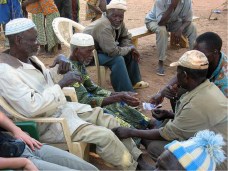
Collecting royalties. Photo Sogreah
Training the management committees
Several training sessions, generally for 3 days, intended for members of new Management Committees several at a time and in the presence of members from already existing committees, were organised, with the task for them to then retransmit the knowledge in their villages, to the users of the water points.
The training themes were as follows : The role of the members of the water committees, management methods, collecting royalties, measuring hygiene and the rules for using the water points, knowledge of the diseases linked to water, methods of transport, storage and manipulating water at home.
All of this training was provided by a state hygiene assistant from the regional hygiene and sanitation department, the JARC health education representative and the monitoring/evaluation representative for the hydraulic programme.
Setting up a database and integrated management systems
Thanks to the making available free of charge of experts by SOGREAH, JARC received training on creating a database intended to capitalise the geographical and physical-chemical characteristics of the structures created. Trips in the field made it possible to learn how to use GPS receivers by taking the coordinates of several structures and by taking advantage of this to take and log the results of water quality analyses.
Certain leaders from JARC became familiar with the Mapsource, Mapinfo software and elaborated a geolocation for all of the structures to which was attached an inventory of all of their characteristics and a logbook for jotting down all of the interesting parameters for monitoring the structures.
5) Where to obtain further information
- Caritas Togo/ JARC : "Training workshop for members of Water Management Committees of JARC in Dapaong".
A 14-page report (May 2011) full of information and practical exercises concerning this workshop, providing details moreover on the roles and responsibilities of a Chairman, Secretary, Treasurer and the Hygiene Managers of a Management Committee, workshop organised within the framework of the programme described hereinabove (in the 3rd example).
Document available on request from the Department of international action and advocacy of Secours Catholique-Caritas France (106 rue du bac 75007 Paris) .



